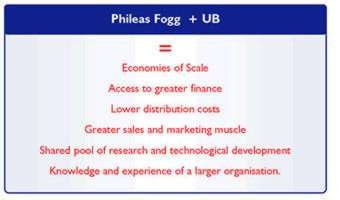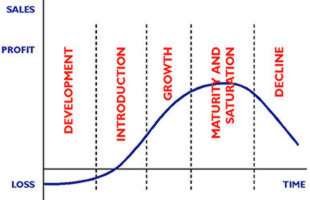
Enterprising businesses must be able to re-invent themselves and their products. This is because consumer expectations change over time and other elements of the general business environment also alter.
A successful, enterprising business knows when and how best to change in order to please its customers.
This case study focuses on one of the UK’s leading savoury snacks, Phileas Fogg. The study analyses how United Biscuits (UB) reinvented Phileas Fogg.
Part of a larger group – United Biscuits (UB)
The history of Phileas Fogg is steeped with innovation based on a small enterprising business with exciting packaging and advertising ideas. Today, like many other organisations in the food industry, Phileas Fogg is part of a much larger group: UB, a multi-national company. It was originally founded in 1948 following the merger of two Scottish family businesses: McVitie & Price and McFarlane Lang, and now has the number 1 biscuit brand in the UK, Netherlands & Spain as well as the number 1 nut brand (KP). UB also has strong brands in France, Belgium, Ireland and Portugal, and is the second largest crisp manufacturer in the UK.
It makes good commercial sense for small businesses like Phileas Fogg to join larger organisations like UB. As part of UB, Phileas Fogg benefits from various commercial economies of scale that can come from marketing, selling and distributing products on a larger scale.
UB has grown through both organic growth and acquisition, a process that has involved taking over and merging with other companies to become the leading manufacturer and marketer of biscuits and snack foods that it is today.
The two main UK divisions of UB are:
- McVitie’s
‘The first choice for biscuits’ including well known favourites such as Jaffa Cakes, Penguin, Hobnobs, Digestives and Rich Tea.
- KP
One of the UK’s largest manufacturers of savoury snacks including Hula Hoops, Skips, KP Nuts and Phileas Fogg.

Phileas Fogg has benefited from being part of a multi-national company. Higher levels of funding are available for developing the brand and distribution costs are lower. There are improved opportunities for shared projects involving research, advertising and promotion. The Phileas Fogg business has also been able to benefit from expertise available elsewhere within the group.
The challenge facing Phileas Fogg, however, was how to retain its innovative culture and individuality within a much larger organisation.
Being enterprising

The Phileas Fogg brand was born in 1983 in the steelworks town of Consett in the North East of England. The steelworks was closing down, creating high levels of unemployment in the area. Four men installed a snack-making machine on the site. With this they created their exciting product lines. One of their acquaintances (‘Jeff’ used a former ice-cream van to sell the products to local shops and to passing customers.
That could have been the whole story, but it was only the start. Fired with enthusiasm from the success of the venture, these entrepreneurs saw the opportunity to exploit a gap in the market. In particular, they realised that they could capitalise on a potential niche market by catering for adult tastes that were not adequately met in the crisps market of the time. Their objective was to create a premium brand with the distinguishing qualities of authenticity, quality and excitement.
Very quickly the new business was able to gain a competitive advantage over rivals through:
- its innovative name: Phileas Fogg – a fictitious explorer from Victorian times
- attractive packaging, promotion and advertising
- the novelty and range of its snacks.
Phileas Fogg was the first to develop tortilla snacks. Incredibly, it took seven years for a competitor to match this innovative product. Phileas Fogg gained a reputation for developing snacks based on foodstuffs and tastes from far flung corners of the globe. With its innovative approach to marketing, the company ensured that Consett, and in particular Medomsley Road, became as famous as the exotic locations that inspired its snacks.
The business has become increasingly adventurous in its quest to develop tasty, unconventional snacks. This approach has helped maintain its growth. Today it employs over 200 staff, including a team of discoverers, who research remoter parts of the world for the next taste bud tingling delight. Over the years, humorous award-winning advertising campaigns have developed the brand’s reputation as the leading innovator within the adult premium snacks market.
Product life-cycle
All products experience a life-cycle. This takes the form of a staged product launch, followed by a period of sustained growth up to maturity, and then finally a decline in sales as product strength diminishes. The length of the life-cycle is not the same for all products, but it is usually many years. With careful nurturing, a product’s life-cycle can sometimes be extended.

Following its success in the 1980s, the Phileas Fogg brand showed signs of slower growth in the 1990s. This was mainly because:
- new competitors had entered the field, supported by heavy investment and clever marketing e.g. Doritos, Kettle Chips and Pringles
- the original Phileas Fogg proposition based on the idea of a Victorian gentleman travelling around the world with his manservant Passepartout had become outdated and lacked relevance
- the strong levels of creativity and innovation that characterised the Phileas Fogg brand in the 1980s and early 1990s had diminished in recent years.
It was clear that if Phileas Fogg was to re-discover its early vigour and success then a new approach to marketing and innovation was required.
Preparing to change

In the world of food manufacture, products are continually being improved and altered to keep abreast with changing times. The process of improvement involves first finding out what consumers want, and then seeking to introduce changes to existing products to meet their needs. Having done this, companies can re-launch a brand or individual product lines using appropriate advertising and promotional techniques to convey the change.
In preparing for the re-launch of Phileas Fogg in June 2002, UB carried out vital preparatory work. The group:
- 1worked with a number of leading entrepreneurs to discuss possible ways of rejuvenating the brand
- 2carried out detailed market research to discover consumers’ views
- 3identified the core elements of the Phileas Fogg brand that needed to be retained. These were:
- commitment to innovation
- absolute integrity
- ongoing research worldwide to identify new snacking experiences.
Making the change
To create a momentum for the change process, work patterns at Phileas Fogg were altered; people responsible for new product development were put into cross-functional teams. New products were developed and fast tracked to re-launch in record time.
Importantly, the organisation was prepared to take risks. Every single product was re-launched and the range was drastically cut to remove under-performing lines that were draining resources.
The aim was to radically change and modernise the Phileas Fogg brand, a process which involved the decision to remove the brand icon, the Victorian Phileas Fogg character. A significant amount of finance – £1.5m – was put behind the brand in the re-launch year. Great emphasis was placed on putting innovation back at the heart of the brand.

Because of its history, Phileas Fogg has always maintained a strong relationship with its employees. This relationship was further strengthened during the re-launch process. All Phileas Fogg employees were and continue to be kept informed of new developments and opportunities to ensure that new ideas are shared across the company.
The Phileas Fogg Company invited and paid for a range of employees from different functions from both management and the factory floor to travel the world and bring back fresh ideas. Pictures of the staff who travelled in search of new ideas are featured on the back of the new packs for all the world to see. The venture generated a host of new product ideas. Some of these have already been launched whilst others will be brought to market in years to come.
Whilst individual brand re-launches will often have specific evaluation criteria that need to be delivered, there are generic measures that most re-launches, including Phileas Fogg, have to achieve.
These include:
- increases in distribution, particularly among major retail chains
- improvements in both the brand’s market share and
- consumer penetration
- increased levels of excitement and enthusiasm behind the brand amongst both the sales team and retailers
- increased levels of media coverage and public interest in the re-launched brand.
Conclusion

The Phileas Fogg Company has a culture that encourages risk taking and has always been well known for its ground breaking, distinctively eccentric, award winning advertising. It has a reputation for frequent new product development and exciting packaging (e.g. a triangular tortilla pack).
Because the company was born out of the hardship of industrial decline, employees have always been fiercely loyal to it. The challenge that faced UB following the acquisition of Phileas Fogg in 1992 was how to build on these core strengths with the added benefit of increased funding and resource without stifling the entrepreneurial spirit that built the brand.
The re-launch initiative has been a huge undertaking. Its impact can be seen across the complete Phileas Fogg product range and can be felt amongst all its employees some of whom research and travel the world looking for new, exciting taste and snacking experiences.
UB is committed to this exciting and enterprising approach. Re-inventing the Phileas Fogg brand demonstrates that all organisations need to create positive consumer led change.
